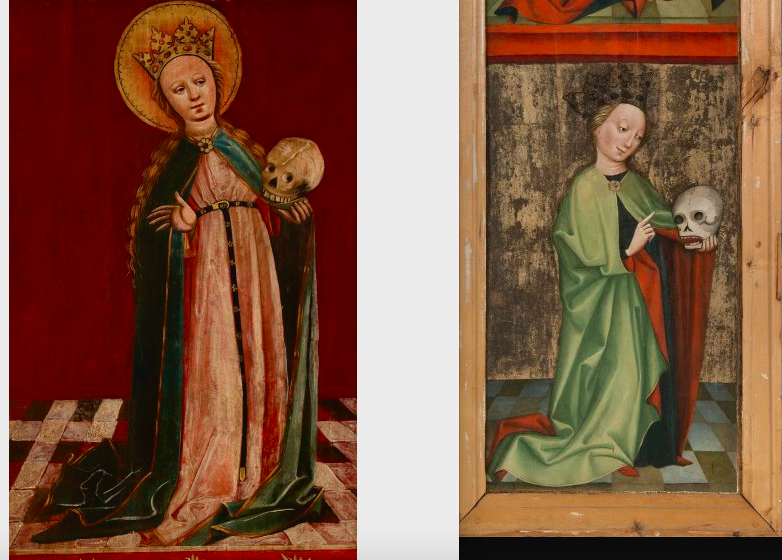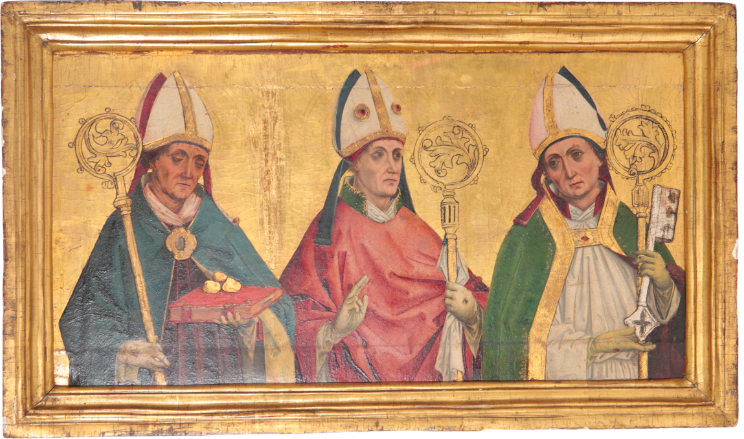
A stolen painting returned to York Art Gallery!

A few years ago I wrote on my blog about two late-Gothic panels from the workshop of Hans Pleydenwurff, that I researched during my stay at York Art Gallery. Those are the posts:
http://en.posztukiwania.pl/2020/04/14/late-gothic-panels-in-york-art-gallery-part-1/
http://en.posztukiwania.pl/2020/05/02/late-gothic-panels-in-york-art-gallery-part-2/
Unfortunately, as I wrote, one of the panels was stolen in 1979. It was on Tuesday, November 13th, when there was no traffic in the museum; someone just took the painting off the wall, hid it and went away. The thief has never been caught.
But the good news is: the painting has just been found! I have received information about it from York Art Gallery, but the news was also published in various media:
To make long story short: on November 17th, 2022, there was an auction at auction house Duke’s in Dorchester: one of the items was a panel, erroneously described as “15th Century Style” with estimated value of £200-400.

https://app.dukes-auctions.com/en/auction/1059-interiors/288-a-15th-century-style-double-sided-altar-screen-fragment-possibly-nuremburg#
Anonymous owner inherited the painting after her father, and she could not provide earlier provenance. It is likely that her father bought it not knowing anything about it himself. She obviously had no knowledge whatsoever, as she accepted an idea of selling the picture as “in medieval style”. Luckily the item has not been sold – at the last moment one of the employees of the auction house realised that the artwork may had been stolen.
They contacted Art Loss Register, who confirmed that in fact the panel belongs to York Art Gallery. In these circumstances the seller decided to give the painting back to the gallery, not expecting any gratification. It also turned out that the panel is in a very good condition.
This is all wonderful, but I got slightly irritated by one thing: press info released by the Art Loss Register was not up-to-date with the scholarly literature on this panel. It looks like nobody checked even the online description published in the project National Inventory of Continental European Paintings:
https://vads.ac.uk/digital/collection/NIRP/id/31602/rec/1
and https://vads.ac.uk/digital/collection/NIRP/id/35804/rec/2
They apparently used information from York catalogue published in 1961, where the panels were described as “Nuremberg School” dating back to ca. 1480. Meanwhile, more recent research (also by German scholars) proved that the panels should be attributed to the workshop of Hans Pleydenwurff, dating back to ca. 1464. They are predella-wings; I believe they were left predella-wings of two different Nuremberg altarpieces, one of which came from a Dominican church. Both panels were given to York Art Gallery in 1957 (not in 1955). And further errors that should be corrected regard identification of the saints depicted on the panels.
The latter issue is not entirely easy – some of those saints are actually difficult to interpret. And so, I decided to dedicate this post to the analysis of the iconography of the York panels.
So, here we go.
In one of the panels, on recto side (the one with the golden background) we may see two female saints: those are Early-Christian virgin martyrs, St Catherine of Alexandria and St Barbara. As virgins, they both have long loose hair; as martyrs, they wear crowns. They are wearing simple robes and cloaks – that was characteristic for the depictions of Early-Christian saints. Catherine holds a book and a sword she was beheaded with (I wrote about her legend HERE), though she misses her usual attribute: a broken wheel. However, she was such a popular saint that she could had been depicted without that specific item.
St Barbara is holding a chalice and wafer, as according to the legend an angel brought her Eucharist before she was martyred.
The thhird person depicted in this picture is a Dominican friar holding a book and T-shaped staff. This attribute led to misidentifying him as St Anthony the Abbot; but St Anthony was not a Dominican. The attribute is not enough – we also have to pay attention to how the saints were clothed in art, and sometimes also to how they wore their hair. In this case it seems we have St Dominic here – according to the 13th-century “Golden Legend” St Peter and St Paul appeared to St Dominic and gave him the staff, which, by the way, is kept as a relic in the cathedral of Silos. Most of the depictions of St Dominic with the staff are Early-Modern, but the legends was known already in the Middle Ages.
On the other side of the same panel we may see St Catherine of Siena (dressed as a Tertiary of Dominican Order), whose attributes are a book and a a crucifix embedded in a heart (that is a reference to her mystical visions). By her side there is St Ursula – another virgin martyr, wearing simple robe and a cloak, with loose long hair and a crown on her head. Her attribute is an arrow, as she was shot by the Huns. And finally, we have another Dominican friar, with a lily (that is a popular attribute for monks and nuns, symbolising chastity) and a Dove of the Holy Ghost by his ear. This is most likely St Thomas Aquinas; it could had been St Dominic, if he were not already depicted on the other side of the same panel.
In the other panel on recto side we may see three holy bishops. One is holding a book and three golden balls – this is St Nicholas. Another holds a key, but this is surely not St Peter. Peter – as an Apostle – was in most cases depicted wearing a simple robe; perhaps sometimes he could had been wearing papal outfit. But the most important thing is that St Peter was in medieval art portrayed as a man wearing moustache and round short beard (as opposed to St Paul, whose beard was pointy). So, in this case we have some other saint: a bishop, whose attribute was a key. It is not St Germain of Paris, as it has once been suggested, but St Servatius. He was a 4th-century bishop of Tongeren (nowadays Belgium); according to his legend, St Peter once appeared to him and handed him a key to Heaven. Servatius was venerated in Nuremberg, which is reflected by his image on the wing of St Wolfgang’s Altarpiece of St Laurent Church in Nuremberg (ca. 1460).

https://upload.wikimedia.org/wikipedia/commons/1/12/St_Servatius%2C_St_Lorenzkirche%2C_N%C3%BCrnberg.jpg
The third bishop, in the middle, is the most enigmatic, as he has no attribute. His higher rank is reflected in the fact that he is wearing a chasuble, and his mitre is decorated with two precious stones. Peter Striedel tentatively suggested it may be St Augustine; Robert Suckale proposed St Adelphus of Metz, venerated in Nuremberg, and sometimes depicted with no attribute.
On the other side of this panel to the right we have undoubtedly Archangel Gabriel from the Annunciation Group (he has his greeting inscribed on the banderole). By his side there are St Lawrence (dressed as a deacon, with gridiron in his hand) and St Sebald, patron saint of the city of Nuremberg. He is dressed as a pilgrim (he was a missionary and a hermit) and he holds a model of a Nuremberg church dedicated to him (Sebalduskirche).
Medieval art used certain visual codes – just as our contemporary pop-culture does. And just as we understand the meaning behind certain emoticons or memes, medieval people quite universally understood their artworks due to certain iconographic details. In case of interpreting saints we should consider everything: not only an attribute, but also clothes and hairstyle. Additionally we should check which saints were actually venerated in the diocese the altar came from. All together because of that sometimes nowadays we misinterpret some depictions; or we actually can’t identify the saint anymore. A good example of that is a female saint with a scull, that has been bothering me for years: she has been depicted in an altar-wing from Zator (Lesser Poland, ca. 1470, National Museum in Cracow) and another, from Hervartó (today Hervartov, Slovakia; ca. 1470, Hungarian National Gallery in Budapest). No, it is not Mary Magdalene – a skull became Magdalene’s attribute later, in the Early-Modern art, and she was never depicted as if she were a virgin martyr (simple clothes, loose hair and a crown).

To the left – panel from Zator (National Museum in Cracow); to the right – panel from Hervartó (Hungarian National Gallery in Budapest)
Shall you have any ideas about this particular saint, feel free to comment. Meanwhile, let’s all rejoice over the fact that a beautiful late gothic panel just came back to York, where it belongs.









